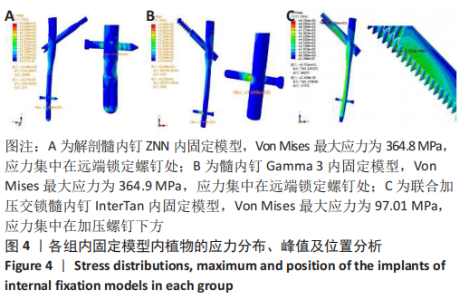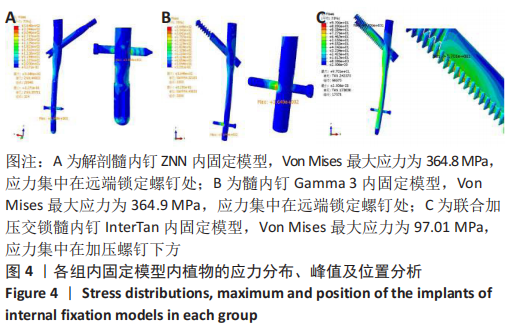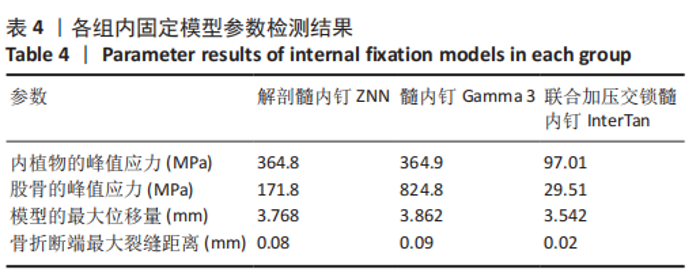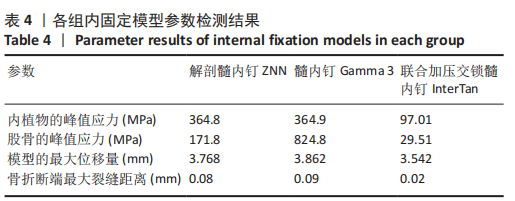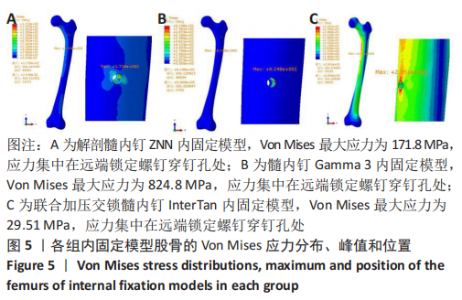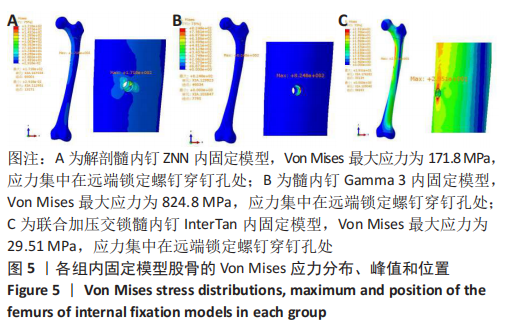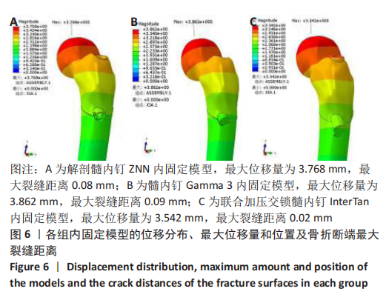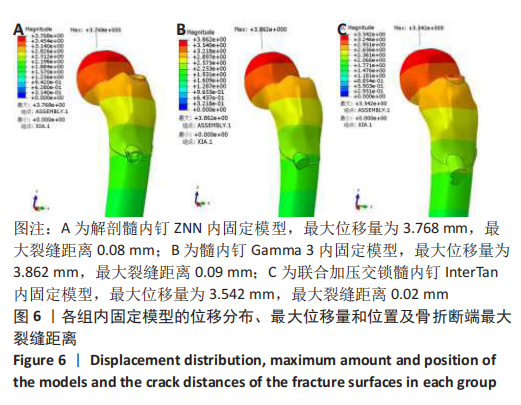Chinese Journal of Tissue Engineering Research ›› 2021, Vol. 25 ›› Issue (27): 4271-4276.doi: 10.12307/2021.181
Previous Articles Next Articles
Biomechanical properties of reverse obliquity intertrochanteric fracture in the elderly treated with three different intramedullary fixations of ZNN nail, Gamma 3 nail and InterTan nail
Chen Jian, Ma Jianxiong, Lu Bin, Bai Haohao, Wang Ying, Ma Xinlong
- 1Department of Orthopedics, People’s Hospital of Xuancheng City, Xuancheng 242000, Anhui Province, China; 2Department of Orthopedics Research, Tianjin Hospital, Tianjin 300050, China
-
Received:2020-10-31Revised:2020-11-03Accepted:2020-12-14Online:2021-09-28Published:2021-04-10 -
Contact:Ma Xinlong, Professor, Doctoral supervisor, Department of Orthopedics Research, Tianjin Hospital, Tianjin 300050, China -
About author:Chen Jian, Doctoral candidate, Associate chief physician, Department of Orthopedics, People’s Hospital of Xuancheng City, Xuancheng 242000, Anhui Province, China -
Supported by:the National Natural Science Foundation of China, No. 81871777 (to MXL), No. 11772226 (to MJX); the Science and Technology Program of Tianjin, No. 18PTLCSY00070, 16ZXZNGX00130 (to MXL); the General Financial Grant from the China Postdoctoral Science Foundation, No. 2017M621087 (to MJX); Grants from Postdoctoral Innovation Project of Tianjin, No. TJQYBSH2017017 (to MJX)
CLC Number:
Cite this article
Chen Jian, Ma Jianxiong, Lu Bin, Bai Haohao, Wang Ying, Ma Xinlong. Biomechanical properties of reverse obliquity intertrochanteric fracture in the elderly treated with three different intramedullary fixations of ZNN nail, Gamma 3 nail and InterTan nail[J]. Chinese Journal of Tissue Engineering Research, 2021, 25(27): 4271-4276.
share this article
Add to citation manager EndNote|Reference Manager|ProCite|BibTeX|RefWorks
| [1] BHANDARI M, SWIONTKOWSKI M. Management of Acute Hip Fracture. N Engl J Med. 2017;377(21):2053-2062. [2] SWART E, KATES S, MCGEE S, et al. The Case for Comanagement and Care Pathways for Osteoporotic Patients with a Hip Fracture. J Bone Joint Surg Am. 2018;100(15):1343-1350. [3] BOONE C, CARLBERG KN, KOUEITER DM, et al. Short Versus Long Intramedullary Nails for Treatment of Intertrochanteric Femur Fractures (OTA 31-A1 and A2). J Orthop Trauma. 2014;28(5): e96-e100. [4] BERGER-GROCH J, RUPPRECHT M, SCHOEPPER S, et al. 5 years outcome analysis of intertrochante-ric femur fractures: A prosective randomized trial comparing a two-screw and a single-screw cephalomedullary nail. J Orthop Trauma. 2016;30(9):483-488. [5] BAZYLEWICZ DB, EGOL KA, KOVAL KJ. Cortical encroachment after cephalomedullary nailing of the proximal femur: evaluation of a more anatomic radius of curvature. J Orthop Trauma. 2013;27(6):303-307. [6] COLLINGE CA, BELTRAN CP. Does modern nail geometry affect positioning in the distal femur of elderly patients with hip fractures? A comparison of otherwise identical intramedullary nails with a 200 versus 150 cm radius of curvature. J Orthop Trauma. 2013;27(6): 299-302. [7] 陈健,左才红,张财义,等.解剖型髓内钉和股骨近端防旋髓内钉治疗老年股骨转子间骨折的疗效比较[J].北京大学学报(医学版), 2019,51(2):283-287. [8] SHIN YS, CHAE JE, KANG TW, et al. Prospective randomized study comparing two cephalomed-ullary nails for elderly intertrochanteric fractures:Zimmer Natural nail versus proximal femoral nail antirotation II. Injury. 2017;48(7):1550-1557. [9] MA JX, WANG J, XU WG, et al. Biomechanical outcome of proximal femoral nail antirotation is superior to proximal femoral locking compression plate for reverse oblique intertrochanteric fractures: a biomechanical study of intertrochanteric fractures. Acta Orthop Traumatol Turc. 2015;49(4):426-432. [10] WEISER L, RUPPEL AA, NÜCHTERN JV, et al. Extra- vs. intramedullary treatment of pertrochanteric fractures: a biomechanical in vitro study comparing dynamic hip screw and intramedullary nail. Arch Orthop Trauma Surg. 2015;135(8):1101-1106. [11] 匡明杰,马剑雄,董强,等.Gamma钉与InterTan髓内钉固定治疗股骨转子间骨折的生物力学性能比较[J].中华创伤骨科杂志,2017, 19(8):708-713. [12] CHEN J, MA JX, WANG Y, et al. Finite element analysis of two cephalomedullary nails in treatment of elderly reverse obliquity intertrochanteric fractures: zimmer natural nail and proximal femoral nail antirotation-II. J Orthop Surg Res. 2019;14(1):422. [13] LEE CH, SU KC, CHEN KH, et al. Impact of tip-apex distance and femoral head lag screw position on treatment outcomes of unstable intertrochanteric fractures using cephalomedullary nails. J Int Med Res. 2018;46(6):2128-2140. [14] KUZYK PR, LOBO J, WHELAN D, et al. Biomechanical evaluation of extramedullary versus intramedullary fixation for reverse obliquity intertrochanteric fractures. J Orthop Trauma. 2009;23(1):31-38. [15] SITTHISERIPRATIP K, OOSTERWYCK HV, SLOTEN JV, et al. Finite element study of trochanteric gamma nail for trochanteric fracture. Med Eng Phys. 2003;25(2):99-106. [16] OKEN OF, SOYDAN Z, YILDIRIM AO, et al. Performance of modified anatomic plates is comparable to proximal femoral nail, dynamic hip screw and anatomic plates: Finite element and biomechanical testing. Injury. 2011;42(10):1077-1083. [17] KWAK DK, KIM WH, LEE SJ, et al. Biomechanical Comparison of Three Different Intramedullary Nails for Fixation of Unstable Basicervical Intertrochanteric Fractures of the Proximal Femur: Experimental Studies. Biomed Res Int. 2018;2018:7618079. [18] REILLY DT, BURSTEIN AH, FRANKEL VH. The elastic modulus for bone. J Biomech. 1974;7(3):271-275. [19] PAPINI M, ZDERO R, SCHEMITSCH EH, et al. The biomechanics of human femurs in axial and torsional loading: comparison of finite element analysis, human cadaveric femurs, and synthetic femurs. J Biomech Eng. 2007;129(1):12-19. [20] BERGMANN G, DEURETZBACHER G, HELLER M, et al. Hip contact forces and gait patterns from routine activities. J Biomech. 2001;34(7): 859-871. [21] ROHLMANN A, MÖSSNER U, BERGMANN G, et al. Finite-element-analysis and experimental investigation of stresses in a femur. J Biomed Eng. 1982;4(3):241-246. [22] CHEN WP, TAI CL, SHIH CH, et al. Selection of fixation devices in proximal femur rotational osteotomy: clinical complications and finite element analysis. Clin Biomech. 2004;19(3):255-262. [23] HONG JB, DAN Y, OUYANG L, et al. Biomechanical study on different lengths of PFNA fixation for unstable intertrochanteric femoral fractures. J Musculoskelet Neuronal Interact. 2017;17(4):299-302. [24] LEE PY,LIN KJ,WEI HW, et al. Biomechanical effect of different femoral neck blade position on the fixation of intertrochanteric fracture: a finite element analysis. Biomed Tech (Berl). 2016;61(3):331-336. [25] 中华人民共和国2018年国民经济和社会发展统计公报[J].中国统计,2019(3):8-22. [26] TAWARI AA, KEMPEGOWDA H, SUK M, et al. What Makes an Intertrochanteric Fracture Unstable in 2015? Does the Lateral Wall Play a Role in the Decision Matrix? J Orthop Trauma. 2015;29 Suppl 4: S4-S9. [27] HAIDUKEWYCH GJ, ISREAL TA, BERRY DJ. Reverse obliquity fractures of the intertrochanteric region of the femur. J Bone Joint Surg Am. 2001;83-A(5):643-650. [28] EVANIEW N, BHANDARI M. Cochrane in CORR ®: Intramedullary nails for extracapsular hip fractures in adults (review). Clin Orthop Relat Res. 2015;473(3):767-774. [29] Roberts KC, Brox WT, Jevsevar DS, et al. Management of hip fractures in the elderly. J Am Acad Orthop Surg. 2015;23(2):131-137. [30] YANG X, WU Q, WANG X. Investigation of perioperative hidden blood loss of unstable intertrochanteric fracture in the elderly treated with different intramedullary fixations. Injury. 2017;48(8):1848-1852. [31] SANTONI BG, NAYAK AN, COOPER SA, et al. Comparison of Femoral Head Rotation and Varus Collapse Between a Single Lag Screw and Integrated Dual Screw Intertrochanteric Hip Fracture Fixation Device Using a Cadaveric Hemi-Pelvis Biomechanical Model. J Orthop Trauma. 2016;30(4):164-169. [32] CHANG SM, SONG DL, MA Z, et al. Mismatch of the short straight cephalomedullary nail (PFNA) with the anterior bow of the femur in an Asian population. J Orthop Trauma. 2014;28(1):17-22. [33] HOFFMANN S, PAETZOLD R, STEPHAN D, et al. Biomechanical evaluation of interlocking lag screw design in intramedullary nailing of unstable pertrochanteric fracture. J Orthop Trauma. 2013;27(9): 483-490. [34] NIE SB, ZHAO YP, LI JT, et al. Medial support nail and proximal femoral nail antirotation in the treatment of reverse obliquity inter-trochanteric fractures (Arbeitsgemeinschaft fur Osteosynthesfrogen/Orthopedic Trauma Association 31-A3.1): a finite-element analysis. Chin Med J (Engl). 2020;133(22):2682-2687. [35] ZHENG XL, PARK YC, KIM S, et al. Removal of a broken trigen intertan intertrochanteric antegrade nail. Injury. 2017;48(2):557-559. [36] BARQUET A, FRANCESCOLI L, RIENZI D, et al. Intertrochanteric-subtrochanteric fractures: treatment with the long Gamma nail. J Orthop Trauma. 2000;14(5):324-328. [37] YU W, ZHANG X, ZHU X, et al. A retrospective analysis of the InterTan nail and proximal femoral nail anti-rotation-Asia in the treatment of unstable intertrochanteric femur fractures in the elderly. J Orthop Surg Res. 2016;11:10. |
| [1] | Wei Guoqiang, Li Yunfeng, Wang Yi, Niu Xiaofen, Che Lifang, Wang Haiyan, Li Zhijun, Shi Guopeng, Bai Ling, Mo Kai, Zhang Chenchen, Xu Yangyang, Li Xiaohe. Biomechanical analysis of non-uniform material femur under different loads [J]. Chinese Journal of Tissue Engineering Research, 2022, 26(9): 1318-1322. |
| [2] | Yuan Jiabin, Zhu Zongdong, Tang Xiaoming, Wei Dan, Tan Bo, Xiao Chengwei, Zhao Ganlinwei, Liao Feng. Classification and reduction strategies for irreducible intertrochanteric femoral fracture based on anatomy [J]. Chinese Journal of Tissue Engineering Research, 2022, 26(9): 1341-1345. |
| [3] | Zhang Yufang, Lü Meng, Mei Zhao. Construction and verification of a full spine biomechanical model of adolescent scoliosis [J]. Chinese Journal of Tissue Engineering Research, 2022, 26(9): 1351-1356. |
| [4] | Zhang Jichao, Dong Yuefu, Mou Zhifang, Zhang Zhen, Li Bingyan, Xu Xiangjun, Li Jiayi, Ren Meng, Dong Wanpeng. Finite element analysis of biomechanical changes in the osteoarthritis knee joint in different gait flexion angles [J]. Chinese Journal of Tissue Engineering Research, 2022, 26(9): 1357-1361. |
| [5] | Pan Baoshun, Fang Zhen, Gao Mingjie, Fang Guiming, Chen Jinshui. Design for posterior atlantoaxial internal fixation system with fusion cage based on imaging data [J]. Chinese Journal of Tissue Engineering Research, 2022, 26(9): 1372-1376. |
| [6] | Li Kun, Gao Erke, Xiong Feng, Wang Xing, Wu Danqi, Li Zhijun, Zhang Shaojie, Liu Yanan, Duo Lan, Li Ziyu. Feasibility of axial transpedicle screw internal fixation in children aged 1 to 6 years [J]. Chinese Journal of Tissue Engineering Research, 2022, 26(9): 1383-1387. |
| [7] | Yang Jun, Yang Qun, Zhang Rui, Jiang Chang. A novel slidable pedicle screw-rod system for lumbar tuberculosis: promoting bone graft fusion by producing stress stimulation to fused segment [J]. Chinese Journal of Tissue Engineering Research, 2022, 26(6): 914-918. |
| [8] | Li Guijun, Fang Xiaohui, Kong Weifeng, Yuan Xiaoqing, Jin Rongzhong, Yang Jun. Finite element analysis of the treatment of hallux valgus deformity by microplate combined with super strong suture elastic fixation [J]. Chinese Journal of Tissue Engineering Research, 2022, 26(6): 938-942. |
| [9] | Li Jian, Bao Zhengqi, Zhou Pinghui, Zhu Ruizhi, Li Zhixiang, Wang Jinzi. Effects of posterior single open-door laminoplasty and anterior cervical corpectomy fusion on cervical sagittal balance parameters in the treatment of multilevel cervical spondylotic myelopathy [J]. Chinese Journal of Tissue Engineering Research, 2022, 26(6): 949-953. |
| [10] | Zhang Xinlong, Ci Wentao, Luo Kaiwen, Yan shi. Internal fixation failure after proximal femoral nail antirotation: causes and reoperation strategies [J]. Chinese Journal of Tissue Engineering Research, 2022, 26(6): 973-979. |
| [11] | Peng Kun. Improvement of the treatment effect of osteoporotic fractures: research status and strategy analysis [J]. Chinese Journal of Tissue Engineering Research, 2022, 26(6): 980-984. |
| [12] | Wen Mingtao, Liang Xuezhen, Li Jiacheng, Xu Bo, Li Gang. Mechanical stability of Sanders II type calcaneal fractures fixed by two internal fixation methods [J]. Chinese Journal of Tissue Engineering Research, 2022, 26(6): 838-842. |
| [13] | Wang Hailong, Li Long, Maihemuti·Yakufu, Chen Hongtao, Liu Xu, Yilihamu·Tuoheti. Finite element analysis of stress distribution of acetabular prosthesis in the Lewinnek safety zone [J]. Chinese Journal of Tissue Engineering Research, 2022, 26(6): 843-847. |
| [14] | Wei Bing, Chang Shan. Finite element analysis of different angles of nail placement in sagittal plane of spinal fracture [J]. Chinese Journal of Tissue Engineering Research, 2022, 26(6): 864-869. |
| [15] | Gao Wenbo, Ma Zongmin, Li Shuxian, Nie Xiuji. Finite element analysis on the effect of implant length and diameter on initial stability under different bone conditions [J]. Chinese Journal of Tissue Engineering Research, 2022, 26(6): 875-880. |
| Viewed | ||||||
|
Full text |
|
|||||
|
Abstract |
|
|||||
